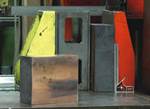The Impact of Hardness
The specific alloy selected for manufacture of a mold will have the largest impact on that mold’s performance, serviceability and life.
The specific alloy selected for manufacture of a mold will have the largest impact on that mold’s performance, serviceability and life. As important is the fact that virtually any metal used to produce a mold or its components will change as a result of exposure to temperatures, gases, pressure and impact exposure during the molding process.
Many of the alloys used in mold manufacturing are precipitation-hardening metals, including ferrous tool steels, non-ferrous copper alloys and aluminum alloys. In its initial application, a mold made of one of these metals will be at a particular level of hardness, grain structure and toughness. Then, after years of use and mold cycling, the metal changes in ways that are not always good or beneficial to mold performance or life. If the mold’s life expectancy is short, then none of the lifelong changes to the metal alloy need to be considered, but if the mold is expected to last for a longer time, then the impending changes become quite significant.
Molders, mold designers and mold builders have a tendency to choose metals that are of the highest attainable hardness for building a mold. While this may seem appropriate for achieving long mold durability, it is important to understand that the precipitation-hardening process continues to raise that hardness level but reduces the alloy’s ductility. Unfortunately, in many cases, what is perceived to be a benefit can lead to an unstoppable process of mold deterioration.
Take for example, the cavity insert from a 48-cavity mold shown in the photo. The cavities were initially produced of a high-hard beryllium copper alloy (C17200), then the surface was hard-chrome-plated. The mold ran for more than seven years before the cavities began exhibiting pitting. The alloy had a hardness of 38 to 40 HRC, which may have seemed like a solid choice when thermal conductivity was considered. However, precipitation hardening actually caused the metallurgical failure.
This pitting condition is similar to what occurs with aged concrete. The once solid and sound structure experiences aggregate fracture and release from the exposed surface, resulting in internal failure. Once this degradation process begins, there is nothing that can be done to reverse or correct it.
Usually, the continued precipitation hardening that occurs while any metal alloy is in application will increase its net hardness by 2 to 5 HRC, resulting in failure. And, as mentioned earlier, with this increased hardness comes a decrease in ductility of around 2 percent, which results in cracking, chipping, internal fracture and surface release.
The lesson learned here is that what seems to be the right material choice in the early stages of designing and building a mold can lead to eventual failure of the mold. To avoid this problem, consider an alloy of a lower hardness (28-32 HRC) and with elongation of about 7 percent. This will allow for the increase in hardness and reduction in ductility that will naturally occur during mold cycling.
Performance Alloys & Services Inc.














